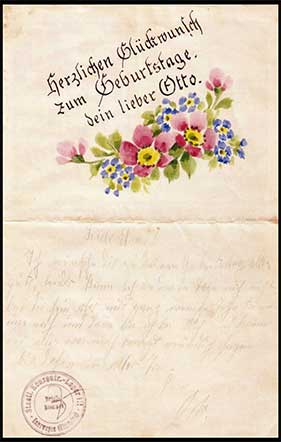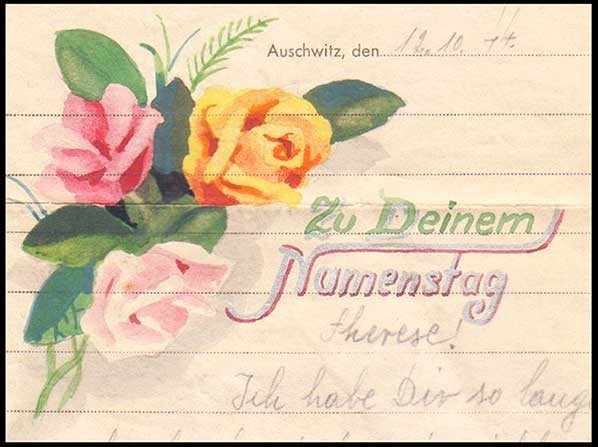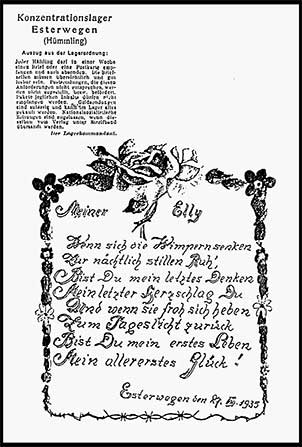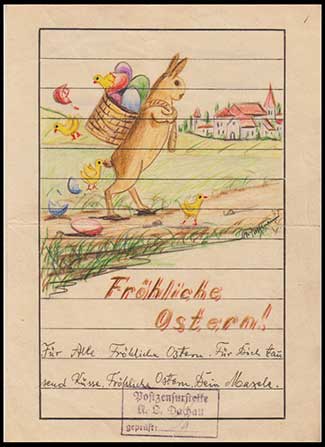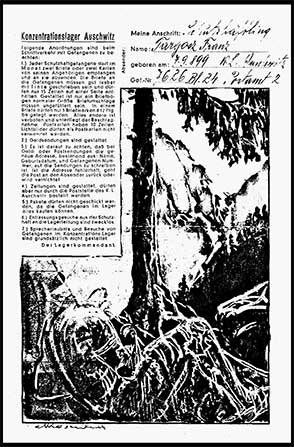Illustrated KZ Mail Part 1
Sooner or later, most collectors of German concentration camp mail will run across prisoner mail objects that have been adorned with illustrations. These illustrations tend to fall into certain categories, with holiday-related drawings or paintings being the most prevalent. Their exact origin is still something of a mystery. The simplest explanation, that a prisoner wished to communicate something more than words can convey to family and friends, is certainly true up to a point. However, in the twisted world of the concentration camps few things were truly simple. In general, prisoner mail rules forbade the inclusion of illustrations or photographs in both outgoing and incoming mail. Prisoners could face suspension of mail privileges, or even severe beatings, for running afoul of these regulations. Thus, when such illustrations are found it usually indicates that a prisoner either had special privileges within the camp, or decided to take a considerable risk with the censor.
Scroll down to learn more about each card
Figure 1
Neutral lettersheet sent from KZ Esterwegen, one of the Moorlager camps, sometime between 1934 and 1936. (Source: Heinrich Heeren, Germany)
The illustration on the lettersheet shown in Figure 1 is typical in many ways. A nice color painting of flowers with a birthday message would appear to be fairly innocuous to most people. However, the prisoner that painted these flowers was confined to KZ Esterwegen, which along with KZs Börgermoor and Neusustrum made up the Moorlager, located in the marshes of the Emsland area in northwest Germany. The prisoners were engaged in peat mining, and were unlikely to have had much time for observing flowers. The prisoner who painted this probably had more in mind than just wishing his relative a happy birthday. In a very real sense such an act represented a tiny but nonetheless sigificant resistance to the Nazi regime.
Figure 2
Folded lettersheet with painting commemorating the recipient’s Name Day, sent from Auschwitz, December 1944. (Source: Søren Nordklint, Denmark)
A similar painting, done by a prisoner in KZ Auschwitz, is shown in Figure 2. A more overt example can be seen in Figure 3. This lettersheet, also sent from KZ Esterwegen, has text framed by an elaborate floral motif that gradually morphs into a string of barbed wire at the bottom. This may or may not have been noticed by the censor, but in any event was allowed to pass.
Figure 3
Illustrated lettersheet sent from KZ Esterwegen in March 1935. (Source: Heinrich Heeren, Germany)
Figure 4
“Happy Easter!” from a prisoner in KZ Dachau. (Source: Søren Nordklint, Denmark)
Figure 5
Pre-printed postal card sent by a Czech prisoner from KZ Sachsenhausen, December 1942. (Source: Søren Nordklint, Denmark)
Figure 6
The drawing on this postal card from KZ Buchenwald celebrates New Year’s Day 1940. (Source: Søren Nordklint, Denmark)
Figure 7
Official pre-printed holiday postal card distributed to (mostly) Czech prisoners in December 1940. This example was sent by Czech prisoner Ctibor Fiala to the Protectorate. (Source: author)
Holiday themes are frequently captured on illustrated KZ mail. Figures 4 through 6 show illustrated mail for Christmas, New Year’s Day, and Easter. Mail with drawings of this sort were much more likely to be tolerated by the camp censors during holidays. This was especially true in KZ Buchenwald, where special holiday postal cards were sometimes issued to the prisoners with standard pre-printed illustrations (Figure 7). Buchenwald was the only camp to routinely use such cards.
Holiday scenes frequently made up the subject matter for the illustrated mail of KZ Dachau inmate Karel Kasák, who for part of his incarceration was confined to the Heilkräuterkulturen (H.K.K.) sub-camp, an agricultural research station situated near the main camp (also used by the SS as an execution site). Kasák, who was employed in illustrating botanical specimens, was a trusted prisoner and had certain mail privileges. Two of his paintings on Dachau pre-printed lettersheets are shown in Figure 8.
Figure 8
KZ Dachau lettersheets with detailed oil paintings by Czech prisoner Karel Kasák. (Source: author and Søren Nordklint, Denmark)
Note that that a small portion of the censor mark may be seen at the lower left on each lettersheet (arrows). The censor has refrained from placing the mark directly over the paintings as a favor to the prisoner. Although both paintings are by Kasák, only the top one is on a letter he actually wrote; the bottom lettersheet was painted for another prisoner.
This brings us to one of the most interesting KZ prisoner drawings known. Figure 9 shows an illustrated pre-printed lettersheet sent by Auschwitz prisoner Franz Targosz to his wife in Bielsko. The drawing is by another Auschwitz prisoner, Mieczyslaw Koscielniak. It depicts a fabled knight, King Boleslaw, asleep in the Tatra Mountains. According to the Polish saga, the knights of King Boleslaw will fight for the freedom of Poland if wakened. It is unlikely that the censor would have any knowledge of this legend, and so he let the letter pass. It might have gone very ill with the prisoners had the drawing’s true nature been comprehended and the matter turned over to the Gestapo.
In Part 2 I will present an additional example of artwork by Mieczyslaw Koscielniak, along with the wonderful paintings of Auschwitz prisoner Josef Dziura. Thanks to Heinrich Heeren, Søren Nordklint, and Wolfgang Haney for providing copies of illustrated KZ prisoner mail. Special thanks to Erik Lørdahl for tracking down some of the illustrations for this article.
Figure 9
“The Sleeping Knight” drawn on an Auschwitz lettersheet. (Source: Wolfgang Haney, Germany)

